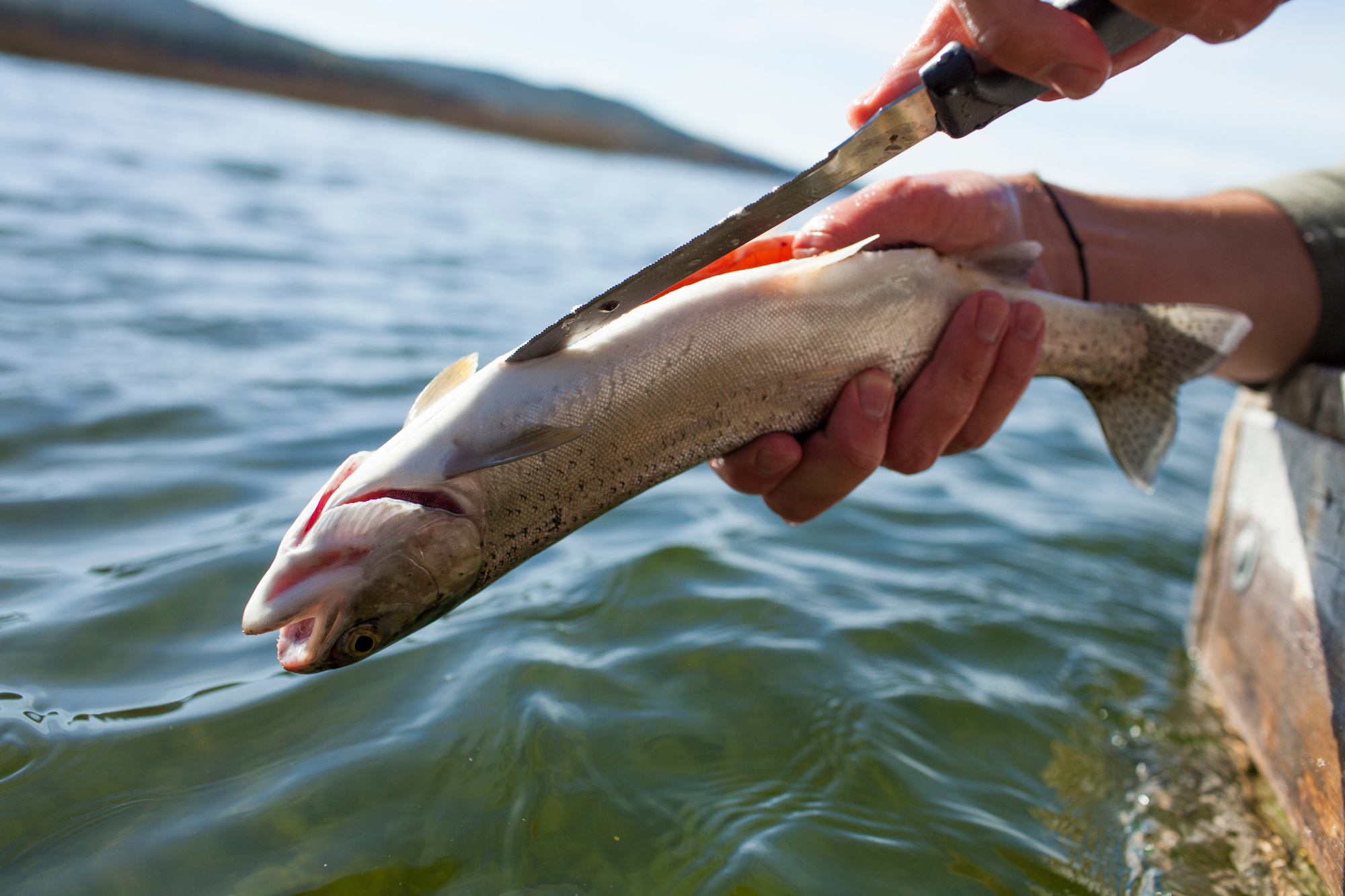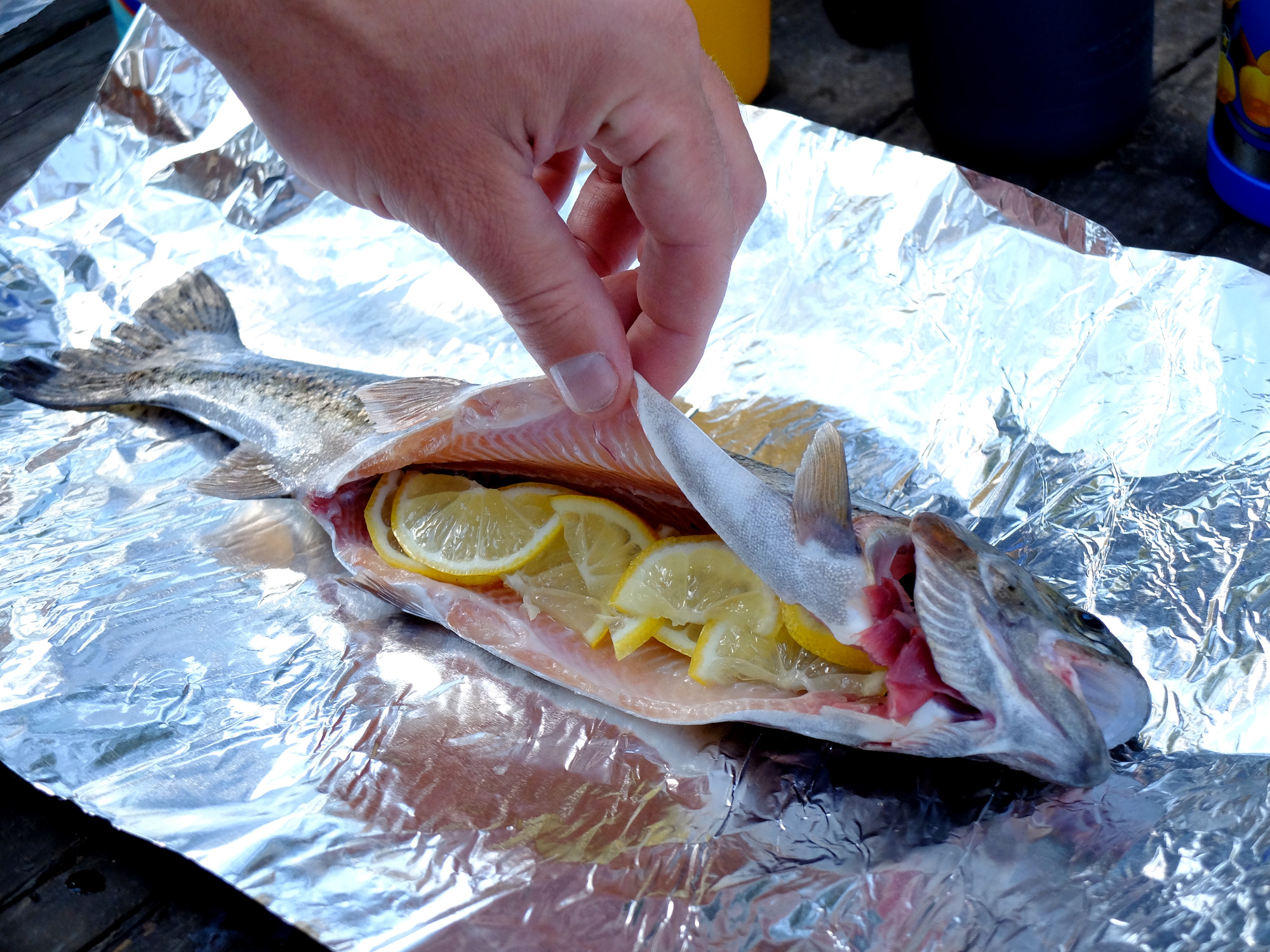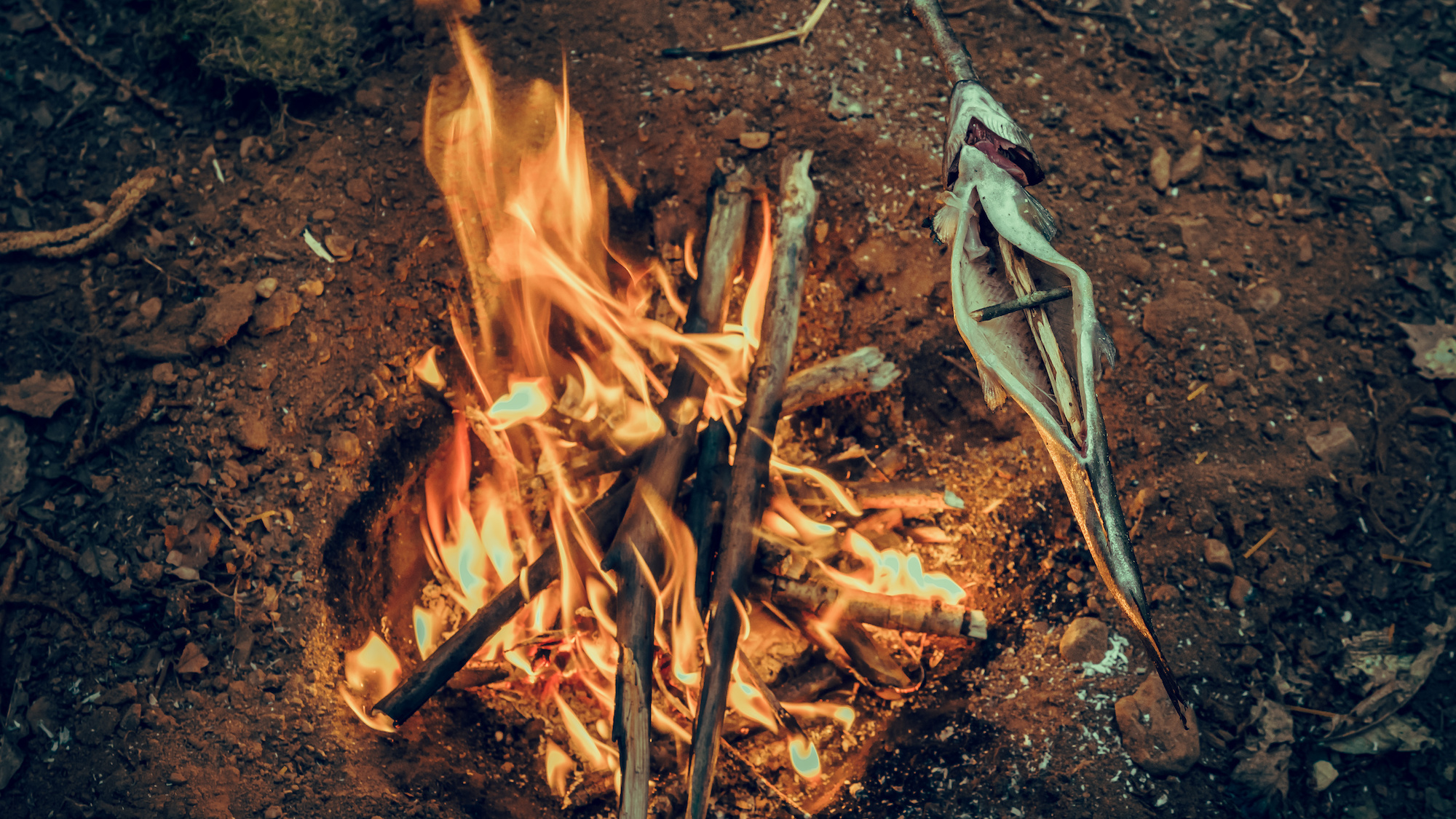If you want to know how to cook trout, you can find a recipe just about anywhere. There are a hundred different ways to bake, broil, and sauté these fish. You could even gussy ‘em up à la almondine or whip together a fine meunière as a finishing sauce. But in this humble angler’s experience, the best, most memorable trout dinners are prepared outdoors.
Nearly every fish I’ve cooked outside was caught, not bought. When I was guiding in Alaska, shore lunches of fresh-caught salmon over a camp stove were part of the program. These days I catch and release most of the trout I catch, but I’ll still harvest the occasional stocker rainbow or a few non-native brookies from one of the lakes near my home in Colorado.
The tips and recipes below work just as well on rainbow trout from the seafood aisle as they do on brook trout plucked from a high-mountain lake. They can also come together just as easily in the backyard as they do at a campsite. So, grab a knife, light a fire, and let’s explore how to cook trout the right way.
Step One: Catch or Buy a Trout
As mentioned, there are two main ways to get your hands on a trout. You can either buy a farm-raised fish wrapped in plastic or you can go out and catch one yourself. For maximum enjoyment of the finished product, I recommend the latter. You can use one of the best trout fly rods or keep things simple and bring a spinning rod along with some of the best trout lures out there.
Either way, double check your local regulations and brush up on your trout identification skills before you start keeping fish. Some lakes and streams are catch-and-release only, while others might allow you to keep rainbow trout and not brown trout, or maybe brookies but not cutthroats. If you want to take a conservation-minded approach, you can make it a personal rule to let wild fish go and only harvest stocked trout.
Finish off your soon-to-be-dinner with a quick snap of the neck or a rock to the head, or by cutting the gills and bleeding the trout. The key word here is “quick.” The longer the fish flops on the bank or struggles on the stringer, the worse it’ll taste. This is because fish release chemical compounds into their meat when they’re stressed, which can impart a bitter taste and make it spoil quicker.
Step Two: Fillet or Gut the Trout
If you bought your trout at a store, whether it’s a package of fillets or a whole, gutted fish, you can skip this step and move on to Step Three. If you harvested your fish, you’ll have to clean and prepare it for cooking. But first you must decide: Do you keep the trout whole or fillet it?
This decision boils down to personal preference, the amount of time you have, and the size of the trout you’re dealing with. There’s no doubt that a properly cleaned and de-boned fillet will absorb other flavors better and have a richer taste. For many people, fillets are also more presentable, and therefore more appetizing, than a whole, cooked fish. If you decide you want to fillet your fish, you can find a complete guide on how to fillet trout here.
But if the trout you’re trying to cook is less than 12 or 15 inches long, or if you don’t have the time or patience to fillet it and pluck out the pin bones, just gut that sucker. This should only take a minute or so:

Gut the trout by taking the tip of your knife and making an incision along the center of the fish’s belly, starting down near the vent (or anus) and working all the way up to the pectoral fins. Then make two more cuts behind and underneath the gill plates. Now you can pinch the throat, pushing your index finger and thumb into the cuts you just made, and pull down firmly. If you did it right, the fish’s guts, gills, and pectoral fins should all come away together, and you’ll be left with an open cavity. As a final step, clean out the thick bloodline that runs along the fish’s spine, either with the tip of your knife or the back of your thumbnail.
Now, all you have to do is rinse your gutted trout or fillets and you’re ready to get cooking.
Step Three: Pick a Trout Recipe
How you decide to cook your trout depends on if it’s whole or filleted. That’s why we’ve included four basic recipes—two for whole trout, and two for filleted trout.
Foil-Wrapped and Broiled Over Hot Coals
The most classic way to cook a trout outdoors is to wrap the fish in aluminum foil and toss it on the coals of your campfire or grill. It’s a tried-and-true method that every camp chef should have in their repertoire.

Ingredients and Tools
- Whole, gutted trout
- Aluminum foil
- Butter
- Lemon
- Fresh herbs and fish seasoning
Instructions
- Tear off a piece of aluminum foil that is longer than (and at least twice as wide as) the trout and lay it flat on a table or cutting board.
- Put a few pats of butter on the foil and lay the whole trout on its side on top of the butter. Inside the cavity of the fish, place more butter along with lemon slices and herbs. Dill, rosemary, and sage are all great options, but get as creative as you’d like. Add a few more pats of butter on the top side of the fish for good measure, as this keeps the skin from sticking to the foil.
- Wrap the fish, folding the aluminum foil over the head and tail and then wrapping around the body. You should have a tightly sealed foil packet.
- Throw the foil packet straight on the coals, or on a grill grate just above them. Don’t make the mistake of placing it right in the middle of a roaring campfire. Your cooking coals should be off to the side of the main fire, and they should be glowing with gray around the edges.
- Cook for around 10 minutes on one side, then flip and repeat. The total cook time depends on the heat of the coals and size of the fish, and it might take some trial and error.
- If you did it right, you should be able to open up a cooled foil packet, lift the fish by its tail, and watch with satisfaction as the meat falls off the skeleton and onto a plate.
Bushcraft Brook Trout

Maybe you forgot the aluminum foil, or maybe you prefer flint and steel to a Bic lighter. Either way, this simple bushcraft recipe is for you. It’s also a good one if you find yourself in an actual survival situation. The smaller the fish, the easier it is to pull off, but it’s a versatile recipe that’ll work for any trout species—not just brookies.
The tools and ingredients list is as short as they come. You’ll need a whole, gutted fish, a sturdy green stick, and a campfire.
Instructions
- Take your green stick, soak it in water, and skewer the gutted trout through the open belly cavity. The stick should run right along the spine and out the fish’s mouth.
- Place your trout-on-a-stick over the campfire. This can be a bit tricky because, again, you don’t want a roaring fire, and you don’t want to put the fish too close to the flames. As a rule of thumb, find a good distance where you can hold your palm over the fire for a few seconds before you have to yank it away. Also be sure to secure the base of your cooking stick by jamming it in the dirt or between some rocks.
- Keep a close watch on the fire and reposition your sticks if needed until the fish is cooked through. You’ll know when it’s done because the skin will be lightly charred and the meat will start to flake off. After it cools, eat with your hands.
Fried Trout Fillets
If you’ve had much experience cooking other freshwater fish, you probably already know how to fry fish. It’s an easy method and it’s always a crowd pleaser. This method can technically be done inside, but it can also get messy and is easily prepared on a camp stove outside.
Ingredients and Tools
- Trout fillets, de-boned with the skin on
- Cast-iron skillet
- Butter or cooking oil
- Flour
- Salt and pepper, along with other spices as desired (onion and/or garlic powder make great additions)
- Lemon and dipping sauce
Instructions
- Dry the fillets with a paper towel.
- Mix the flour and seasoning in a large plate, bowl, or other container.
- Coat the fillets with seasoned flour, then set aside. While they rest, heat the butter or oil in a cast-iron skillet over your stove or campfire. When the butter starts bubbling or the oil develops a wavy sheen, you’re ready to cook.
- Drop your fillets in the hot skillet and fry for 3 to 4 minutes on each side, or until they’re cooked through to a beautiful golden-brown. Finish with a squeeze of lemon and serve with your favorite dipping sauce.
Grilled Northwest Style
This is easily my favorite way to cook steelhead trout, but it works with regular rainbow trout and other non-migratory trout too. It’s also a killer way to prepare salmon. Either way, you’ll need a fish that’s big enough to produce two large fillets, so about 18 to 20 inches long or longer.
Ingredients and Tools
- Hot grill or a campfire with a grill grate
- Trout fillets, de-boned with the skin on
- Makings for the marinade:
- 1/2 cup soy sauce
- 1/2 cup olive oil
- 2 Tbsp minced garlic
- 2 Tbsp chopped rosemary
- 1 Tbsp brown sugar
- Salt and lemon pepper
Instructions
- Mix your liquid marinade and then place in a bag or sealable container. Drop in the trout fillets. If possible, marinate them overnight or for a full day. If you don’t have that much time, a couple hours in a Ziploc bag will do.
- Get the grill sizzling hot, then place fillets on the grate, skin side up. Grill for 8 to 10 minutes or until the meat is seared with good char marks. Flip fillets and finish grilling with skin down. If you have some extra marinade, brush it over the top. (It’s okay if the skin chars completely during this last step, as the meat will separate from the skin during cooking and slide right off when plated.)
- Pull the fillets when they’re cooked almost all the way through. You want an internal temp of around 145°F. As with most fish and other wild game, the last thing you want to do is overcook it.
FAQs
Does trout have bones?
Yes, trout are a bony fish. They have rib bones and spine bones, and these can be worked around with a sharp fillet knife and proper technique. Trout also have pin bones, which you’ll see poking out of the fillets. The best way to remove the pin bones is to pluck them out one at a time with a pair of tweezers or forceps.
Do you eat the skin on trout?
You can eat the skin on trout. It’s full of protein and Omega-3s. A lot of people don’t like it, though. The skin will typically taste better fried or grilled than it will if the fish is cooked whole in a foil packet.
What do you eat trout with?
Fresh-cooked trout pairs wonderfully with roasted potatoes, leafy greens, and a light Pinot Noir. You also can’t go wrong with mac ‘n cheese from a box and a Miller Lite.
Final Thoughts

We could rattle off plenty more tips for how to cook trout, but the recipes above will give you plenty of options to experiment with. Which one you end up using will depend on the tools and ingredients you have at hand, the size of the trout, and your own personal taste. Just remember: It’ll taste better if it’s cooked outside.
